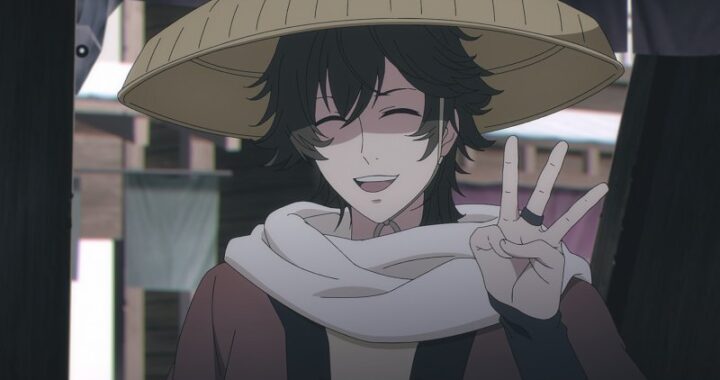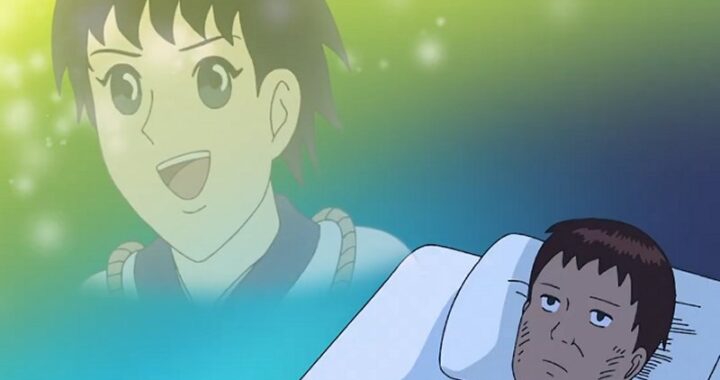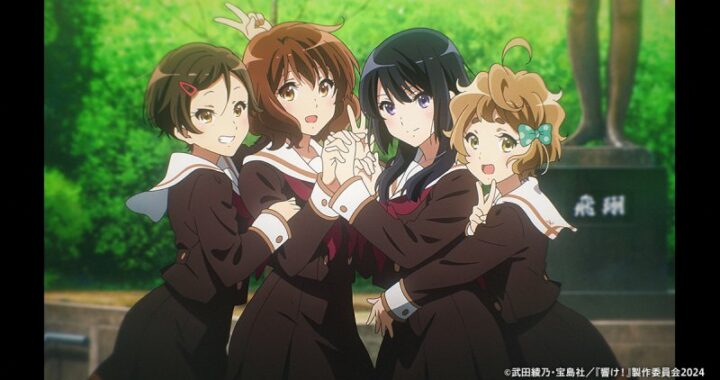 While continuing to offer more glimpses into the past and playing around in the present, the introduction of a new character completely shifts the dynamic of the show in the last episode.
While continuing to offer more glimpses into the past and playing around in the present, the introduction of a new character completely shifts the dynamic of the show in the last episode.
What They Say:
Tension surrounds the whole town as the police finally start cracking down on the disputes between Tanokura and the Ginzame gangs. With the police seemingly siding with Tanokura’s gang, the Ginzame look to be taken down pretty hard.
But even as everyone attempts to lay low, the mystery behind an unidentified man begins to circulate. Who is he? What is he looking for? And how do Tanokura and George Kodama fit into the picture? Missing cars filled with gold and platinum, abandoned copper mines, and an ex-con – trouble just blew into town.
The Review:
Audio:
The audio presentation for this series is pretty straightforward as we get the original Japanese language and an English dub with both of them in stereo encoded at 224kbps. The series has a very good stereo mix that features a lot of small moments of directionality with both voices and ambient sound effects that help enhance the mood and pacing of the show. It’s not terribly strong and can be difficult to discern a lot of it if there’s other noise in the room, but there are some very enjoyable small moments. The show is heavily focused on quiet moments and the dialogue so these things are handled well overall. Throughout the presentation, the dialogue is clean and clear and we had no problems with dropouts or distortions on either track during regular playback.
Video:
Originally airing in 2001, the transfer for Kaze no Yojimbo is presented in its original full-frame aspet ratio. Animated by Studio Pierrot, the show works a particular style where the colors are solid and provide a good mixture of subtle earthy tones and a number of very vibrant areas to contrast it from time to time. The darks are very well done, particularly one scene where it shows the night sky in the distance but you can still make out the darker shadow of the tree and mountain line along the horizon, though the two nearly blend. There’s some cross-coloration showing up in a few parts of the episodes but it’s pretty minor. Where it’s most noticeable is in the episode title cards that are after each opening sequence where the character artwork is pretty much full of rainbows. Other than that, this is a very good-looking transfer.
Packaging:
Paying homage to its roots, the cover here with the original series name combined with the color palette of an almost sepia feel gives an impression of an old movie poster from something quite some time ago. George continues to be the only character in full color here as he’s done in a running shot while the backdrop of the woodlands along with two other characters in the soft browns and grays balances it out. The style isn’t terribly appealing but there’s something about it that just seems to work right in context with the show itself. The back cover is a bit more traditional looking with a number of screenshots set up as a collage across the middle as well as a few other places. There’s a brief summary of the premise that lets everything grow from there and a rundown of the basic features, including listing the episodes by number and title. The insert replicates the front cover artwork and opens to a two-page spread that has individual summaries for each of the episodes with faded-out shots from the episodes as well as a shot of George from an illustration piece. The back of the insert has the main rundown of production information including fully credited bilingual cast listings. A limited mini-cel is also included with the first round of releases, which is basically a flimsy pencil board that has an image of George in one of his relaxed demeanors.
Menu:
Done in a letterbox mode using some of the material from the show, the menus here are simple yet it feels like they’re missing something since the extras section isn’t here. With the black-and-white design combined with an almost upbeat opening song playing along, it just has a weird vibe to it that doesn’t quite seem to fit with the show. The menus are technically solid and have good access times, use my player’s preset preferences and highlight which languages are selected as well.
Extras:
None.
Kaze no Yojimbo had our interest held pretty well with the first volume of the series as it laid out the basic mystery of a train car being stolen some years before. It moved things forward to the present day where it’s still missing and something of a mystery to some and we saw George come to a town where there’s some obvious history to it. The colorful town with its split personality provided an intriguing backdrop to the tale with there being two real sides to it. With the second volume though, the show wasn’t able to maintain its level of interest as the stories seemed to meander. While they provided background information and helped flesh out an obviously lengthy story and detailed town, there wasn’t enough forward momentum to really hold one’s interest.
This volume manages to start to pull some of those plot elements back together and return to the momentum. This makes up the first three episodes of this particular disc and brings us to the halfway point in the show, which is a real turning point. Before that, much time is spent in the town where we see how the Ginzame and Tanokura sides are working against each other for their own reasons. With Tanokura being a local, born and bred, he’s able to take advantage of that status and use the police’s willingness to help a local before an outsider takes down his competition. To Ginzame, anything they do is now a criminal offense and they’re taken off the street faster than the boss can realize. Add in the gambling train information and Tanokura is able to use his influence enough with the police to ensure that Ginzame is kept plenty far away and occupied from whatever he’s doing.
This becomes apparent across the three episodes as various incidents play out, from some Ginzame guys checking out the Tanokura mines looking for where the train may be to a setup where some Tanokura ruffians make a move on George while out on a date with Miyuki in White Town. Simply crossing the sides of the town is seemingly almost used against the Ginzame folks. The slow power struggle and the obvious advantage of Tanokura is interesting to watch throughout this, especially with some of the revelations that Miyuki makes as well as the flashbacks that George goes through to his youth and the incident with the train itself.
The turning point episode is where everything felt like it changed. With George and Kimujuku only coming into play as very brief bookend tales, the show focuses on a town up the line where the train lets off Rin Ginzame, the brother of the two Ginzame we’re already familiar with. He’s finished out his sentence in prison – early at that for being a model prisoner – and is making his way back home but stopped off for a drink and to walk under the stars. Rin stops in a local bar and as it plays out we learn the history he has with it and the man behind the bar, as well as the detective that eventually arrives. This episode plays out with a lot of exposition but does it with a great amount of style and beautiful execution.
In fact, it’s almost seemingly animated differently than the rest of the show so far. It has a lot of panning sequences and a more three-dimensional look to it as the camera moves around and slides in to focus on Rin’s face as he turns around. His face provides a lot of emotion in this episode and with more animation applied to it, it’s incredibly fluid and gives a very primal feel when appropriate. Rin’s arrival on the scene and the way he’s introduced here is something that’s obviously going to play big into the remainder of the series and it’s done beautifully. While a lot of him is still a mystery, so many important useful bits are given here that he feels more fleshed out than the lead character in a couple dozen other series. His arrival has completely re-invigorated my interest in the show.
In Summary:
Kaze no Yojimbo has been terribly uneven during the first half of the series but provided a lot of tantalizing bits. There aren’t any other series I can think of that are similar in its nature so some of it is just an unfamiliarity with this particular style. This volume brings in a lot more of what I like while also bringing some of the various plot threads closer together. Mixing in the past and present is something that this show does very well and these episodes bring a lot more of that to the fore and give it the momentum that it needed to make it feel like we’re engaged in a story rather than just exposition. Kaze no Yojimbo isn’t near the top of my pile to watch when new shows come in, but it is one that I set aside for complete concentration and absorption.
Content Grade: B
Audio Grade: B
Video Grade: B
Packaging Grade: B-
Menu Grade: B-
Extras Grade: N/A
Released By: Bandai Entertainment
Release Date: August 10th, 2004
MSRP: $29.95
Running Time: 100 Minutes
Video Encoding: 480i/p MPEG-2
Aspect Ratio: 1.33:1
Review Equipment:
Sony KDL70R550A 70″ LED 1080P HDTV, Sony PlayStation3 Blu-ray player via HDMI set to 1080p, Onkyo TX-SR605 Receiver and Panasonic SB-TP20S Multi-Channel Speaker System With 100-Watt Subwoofer.



